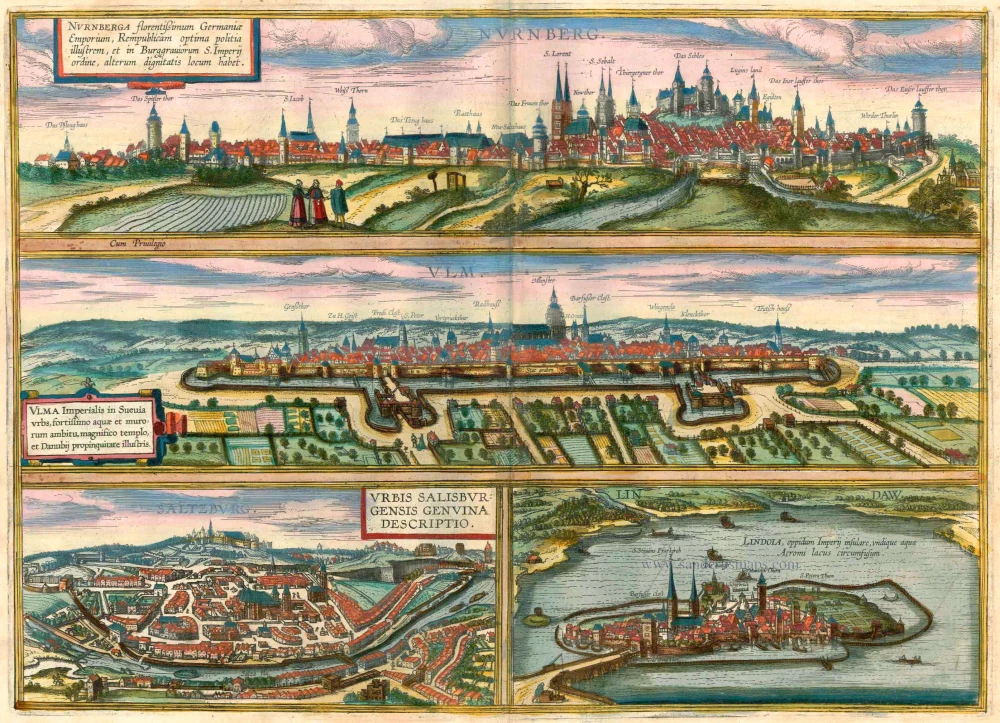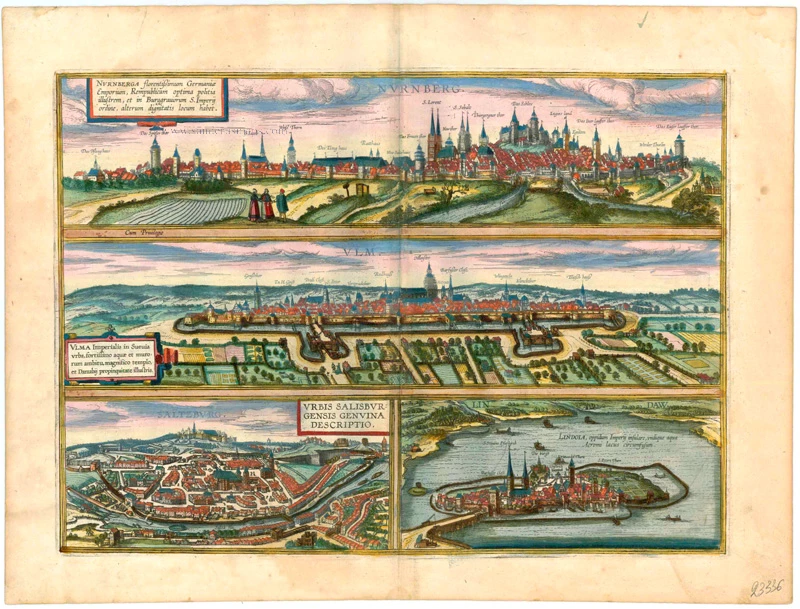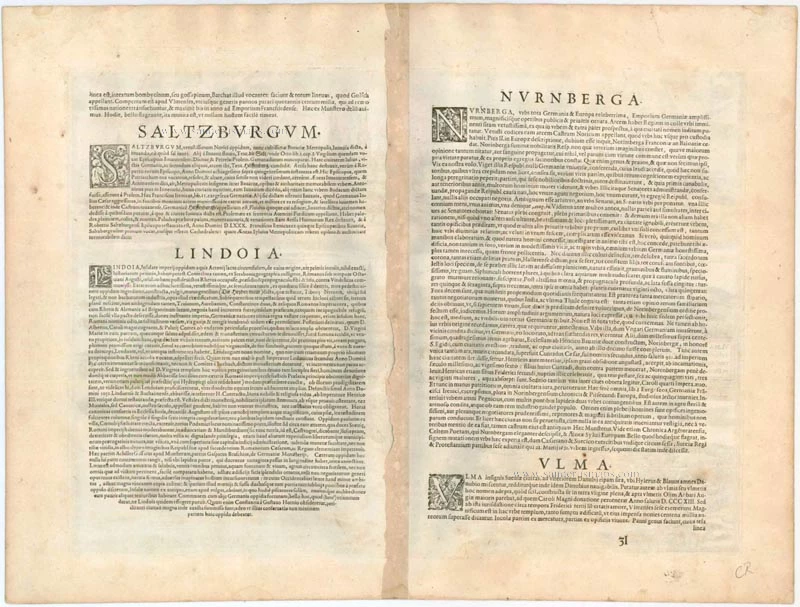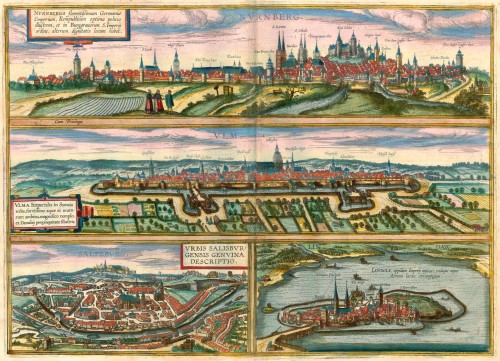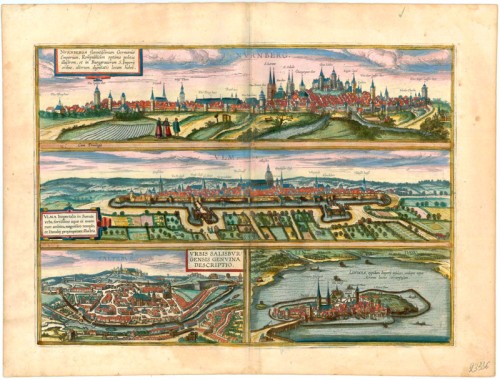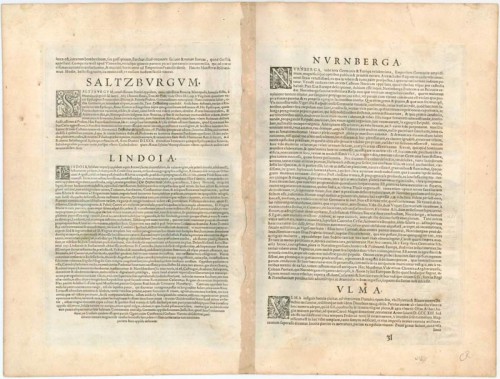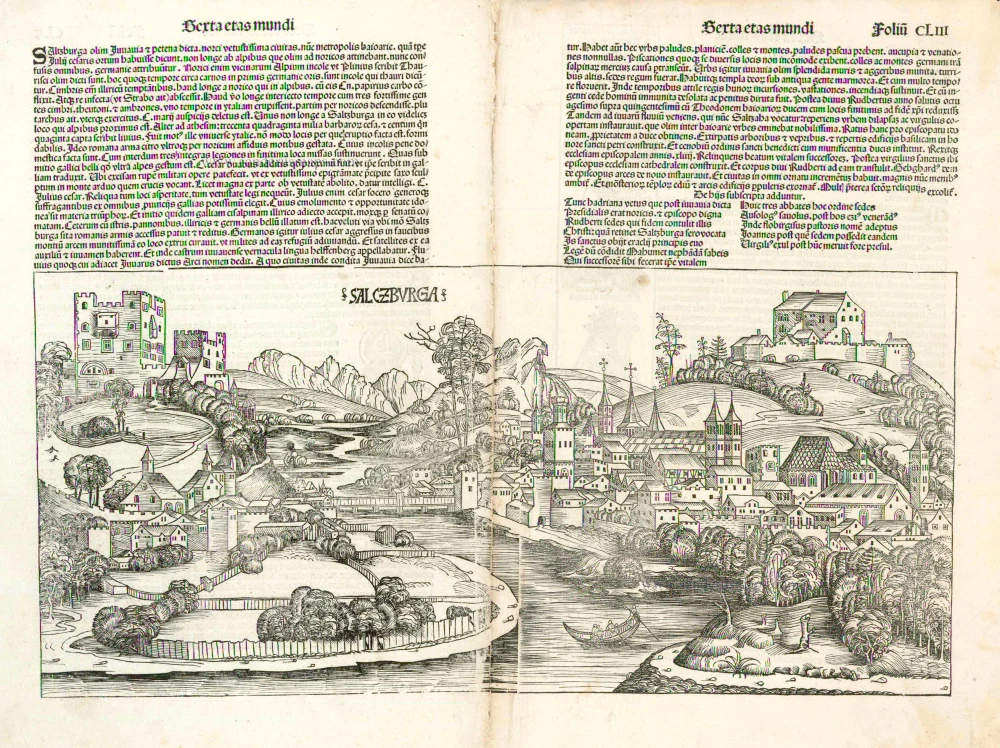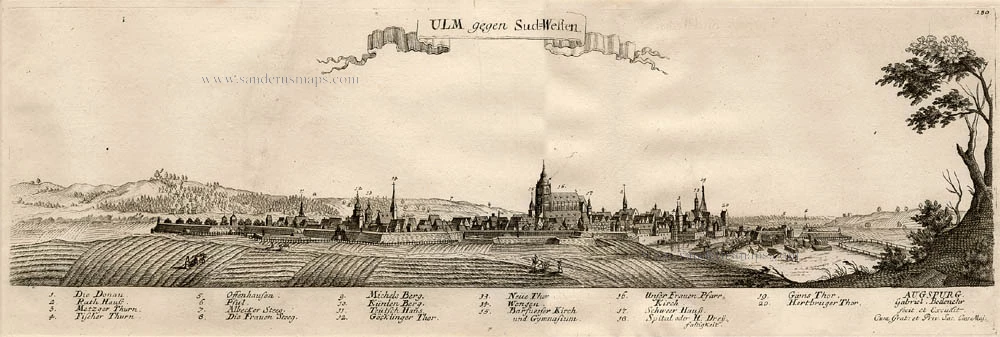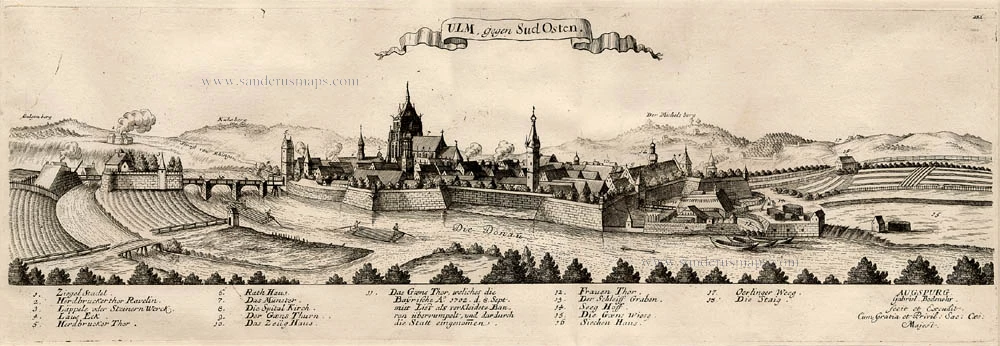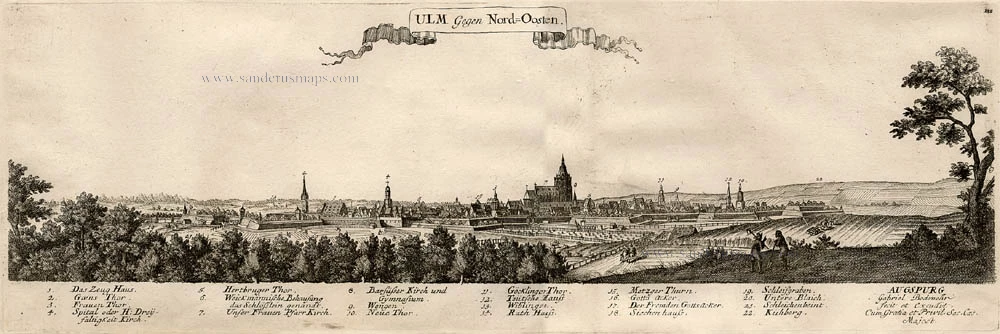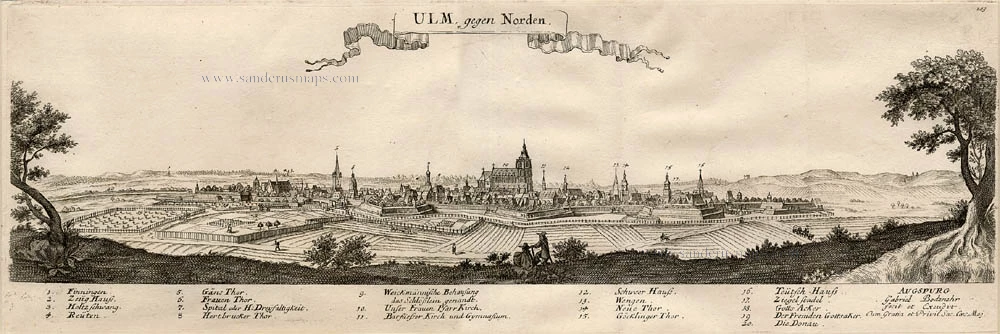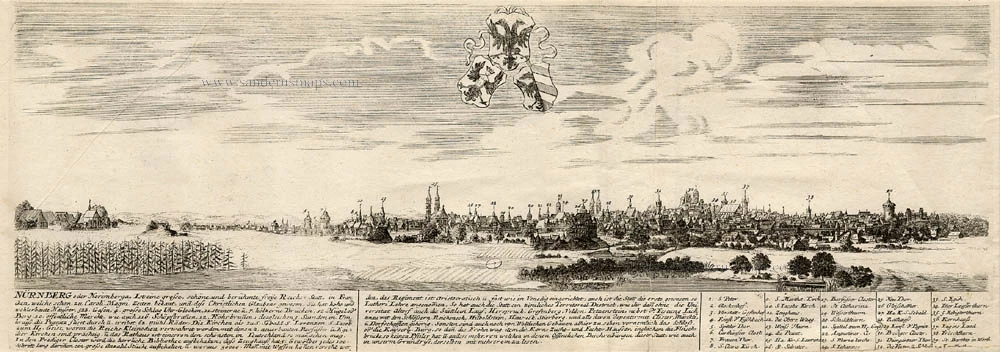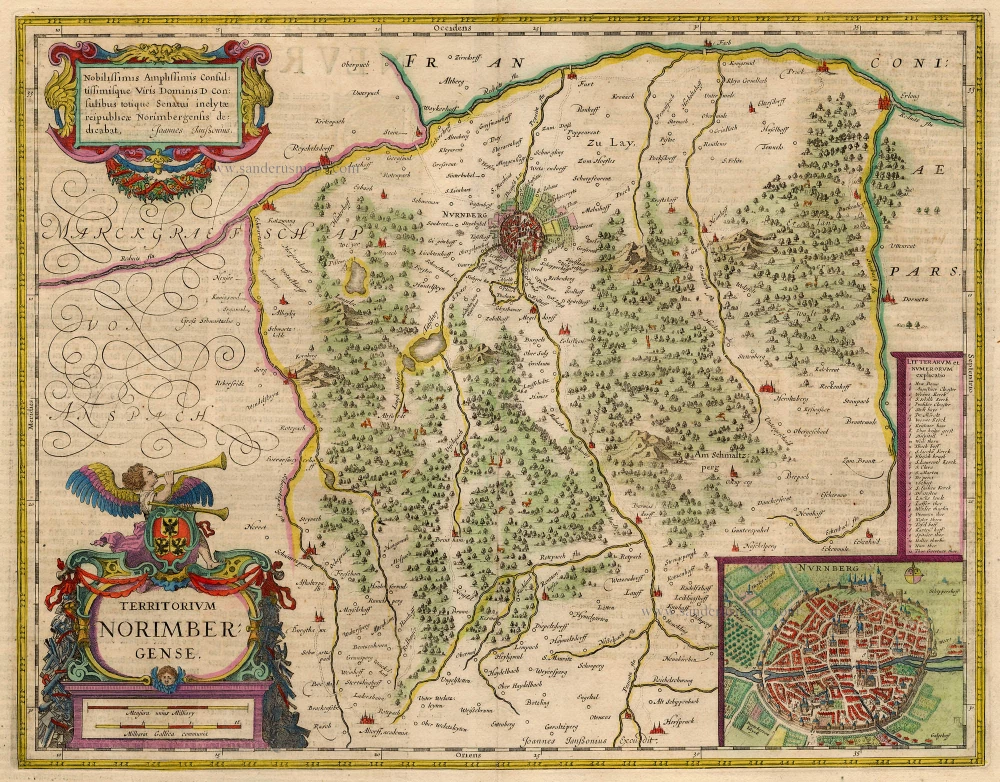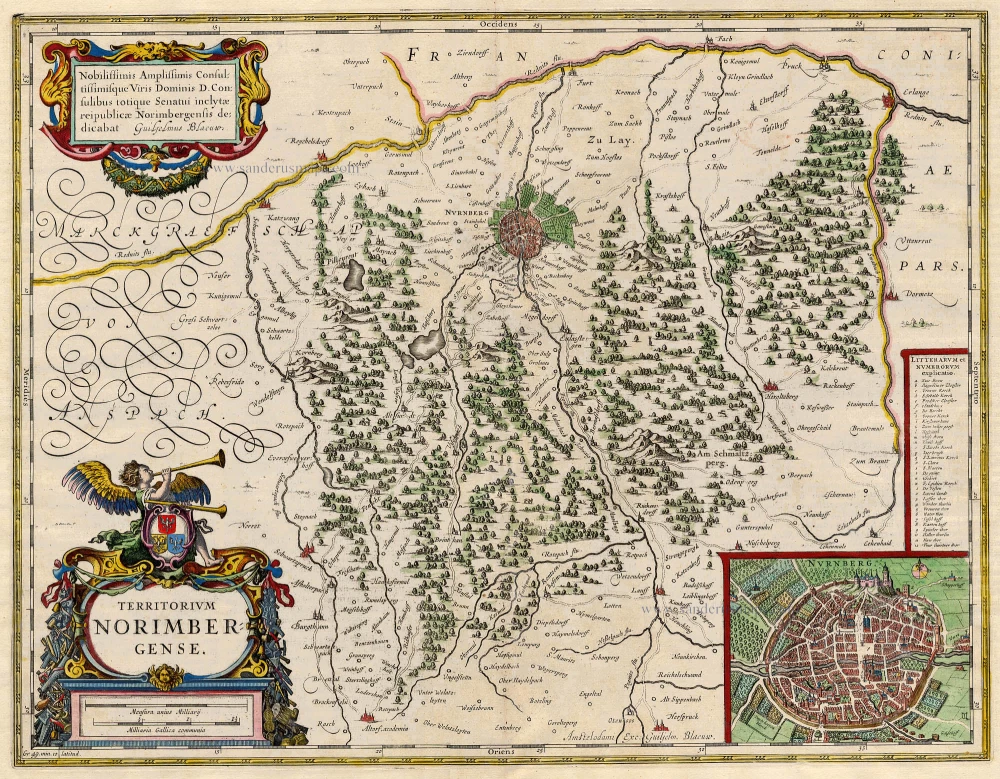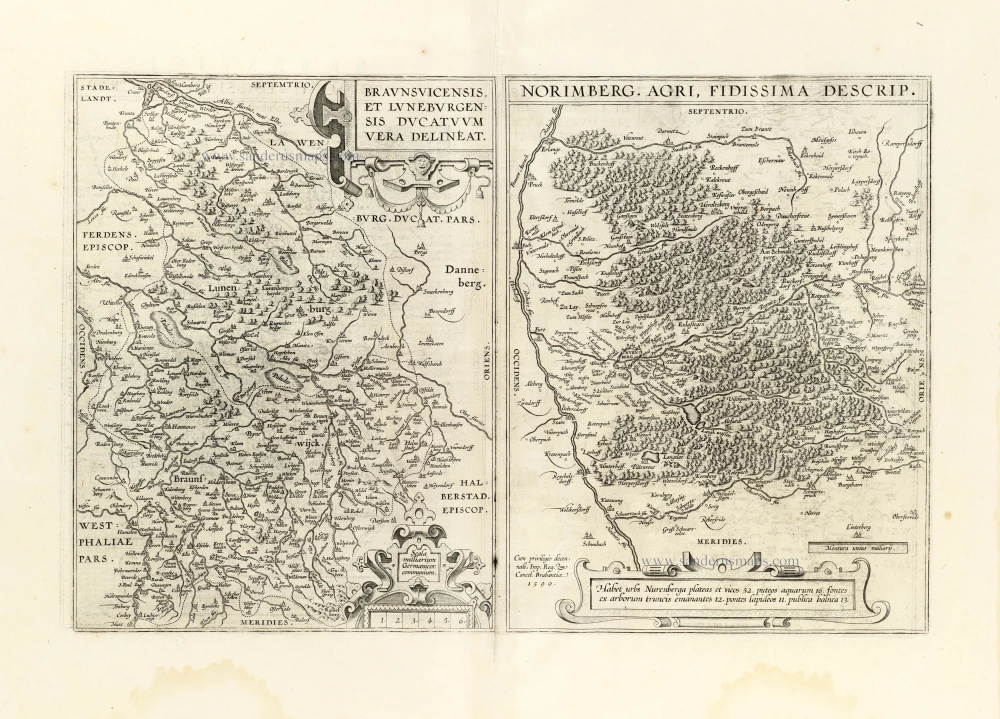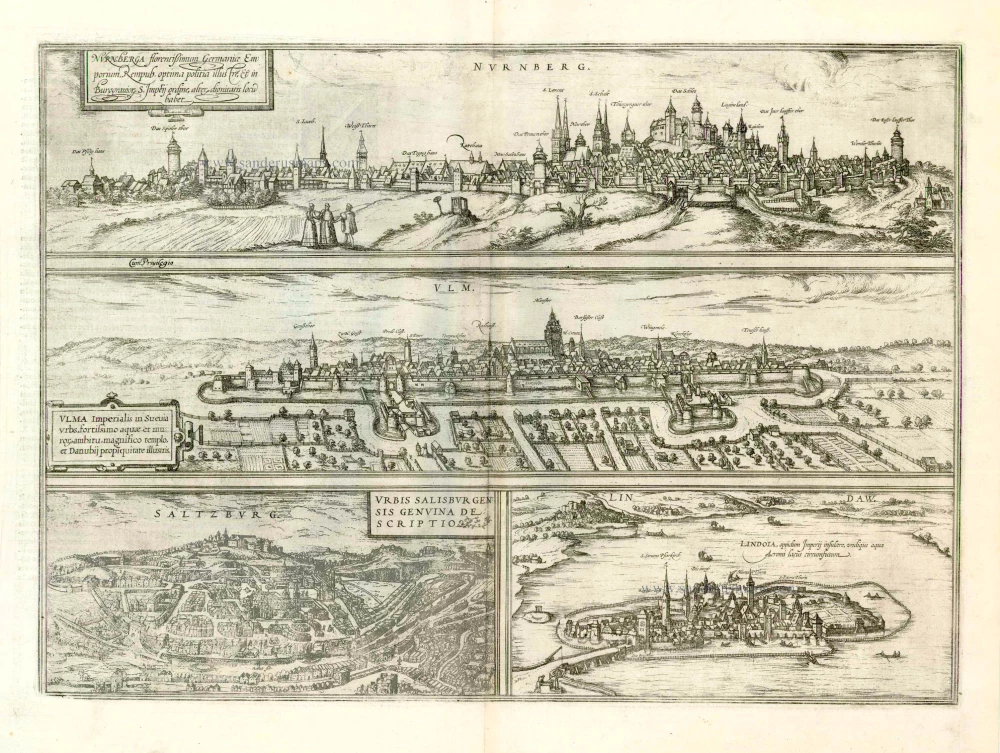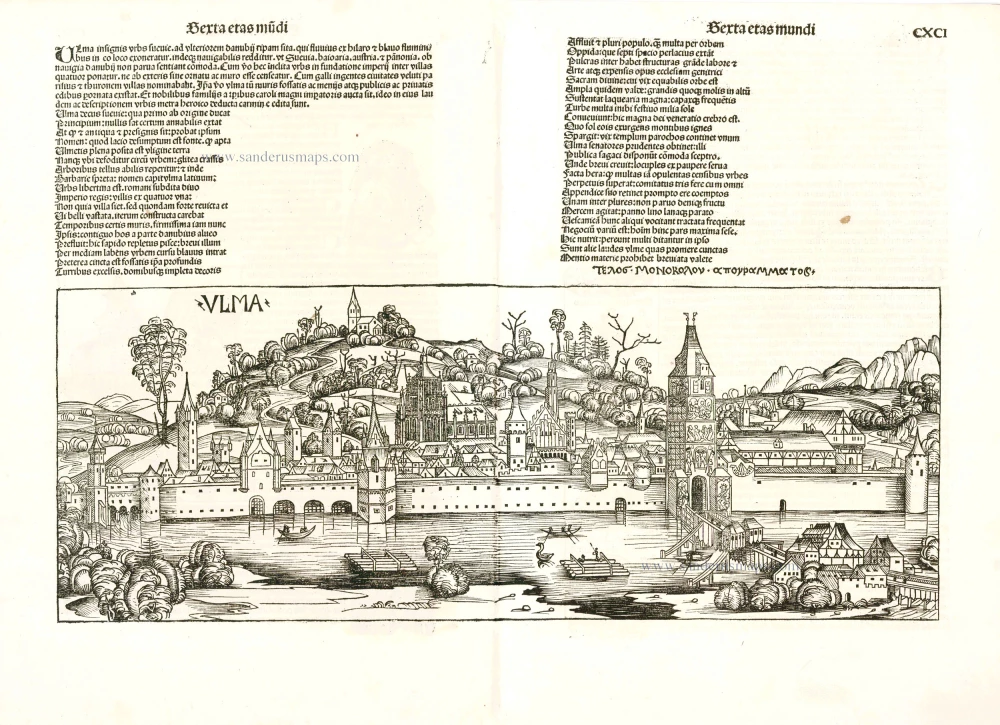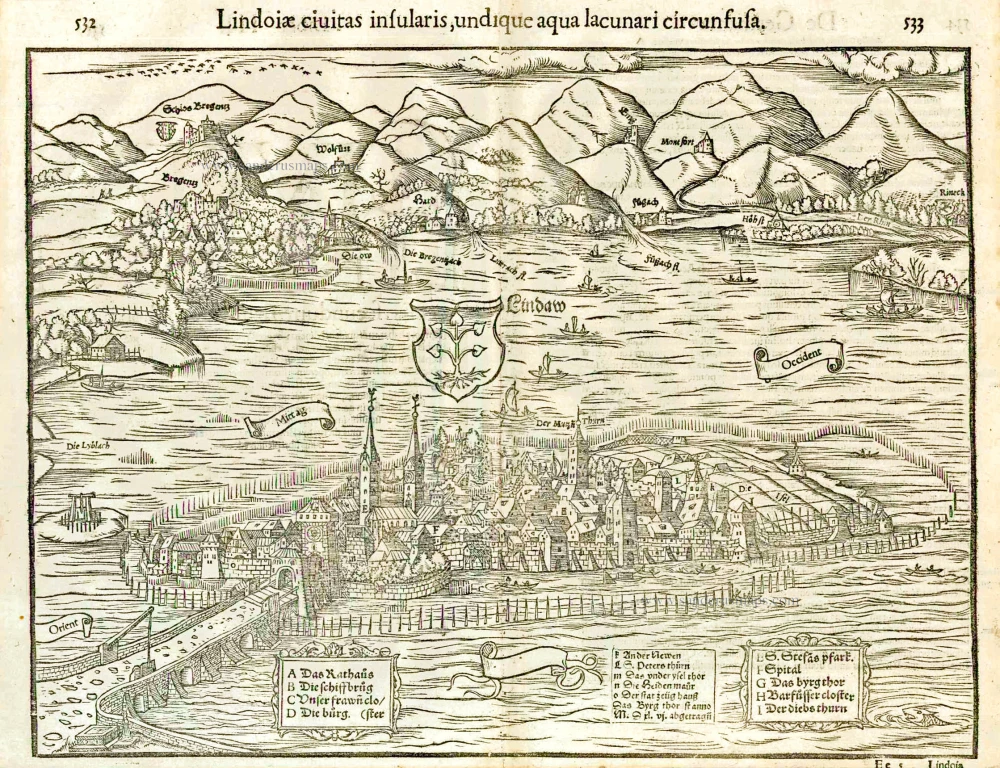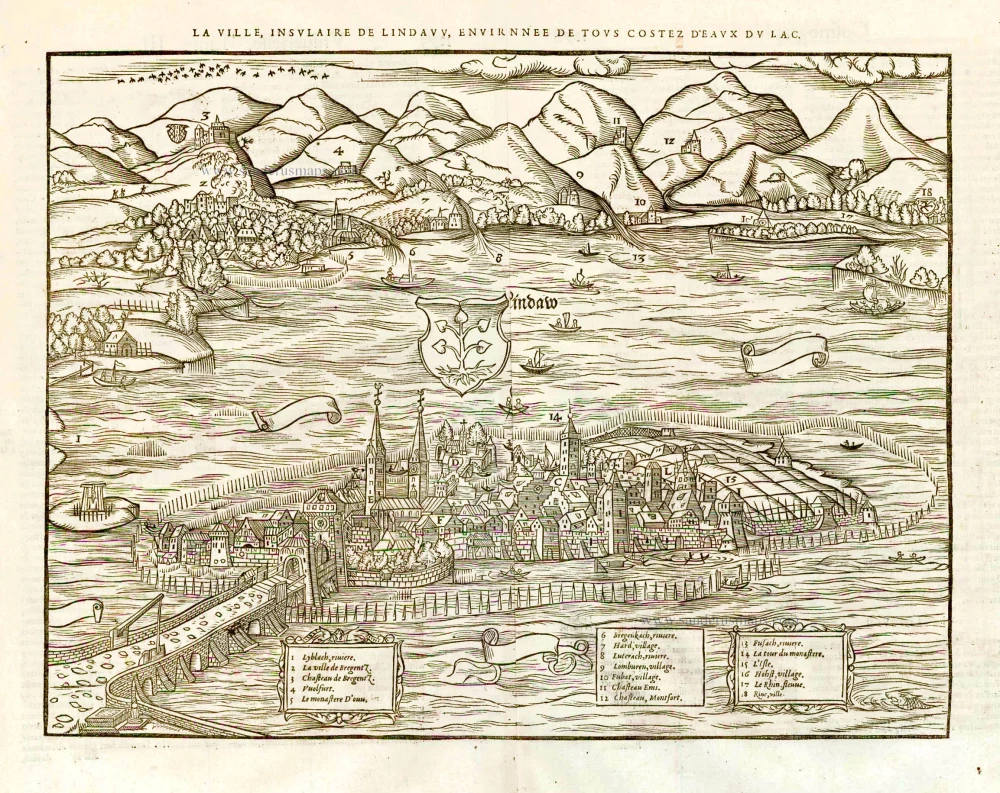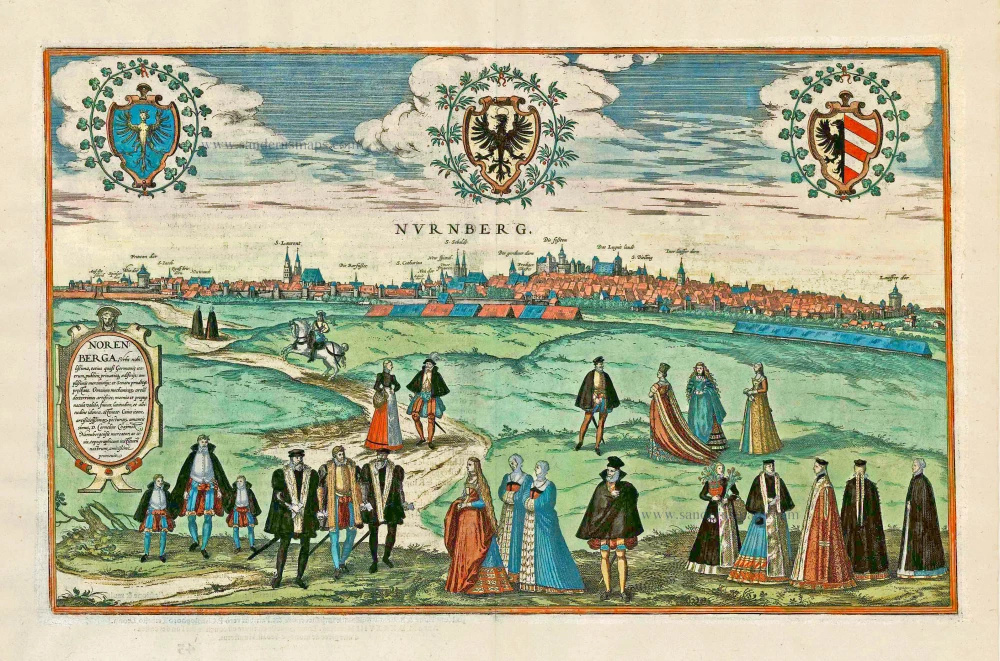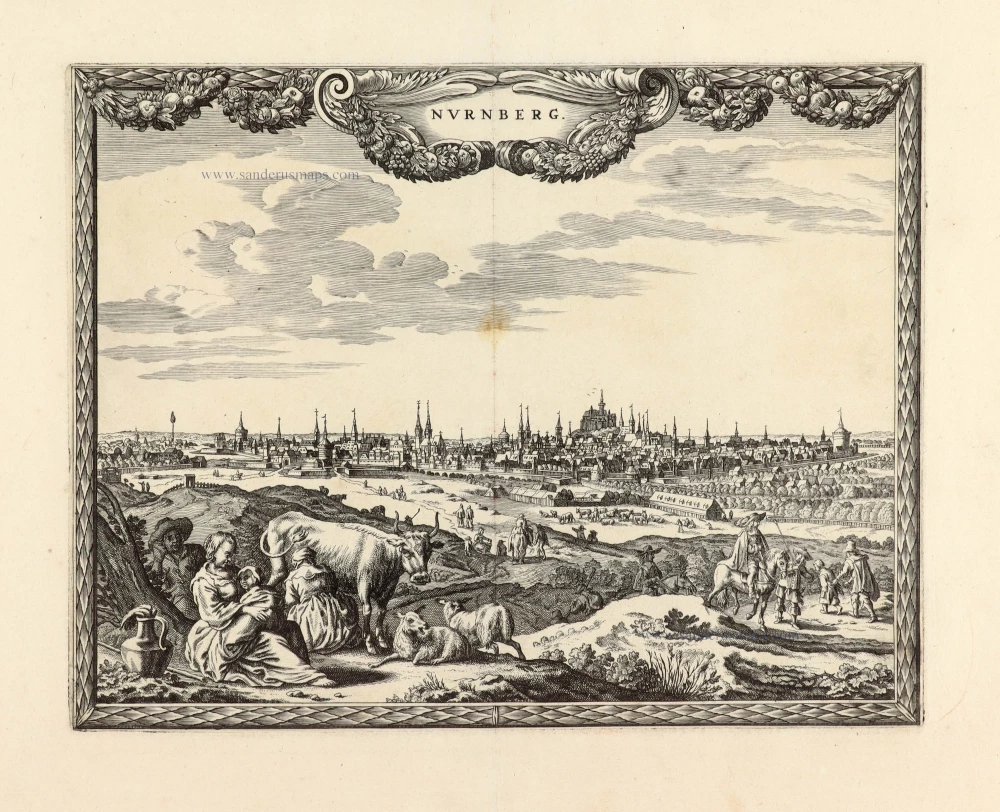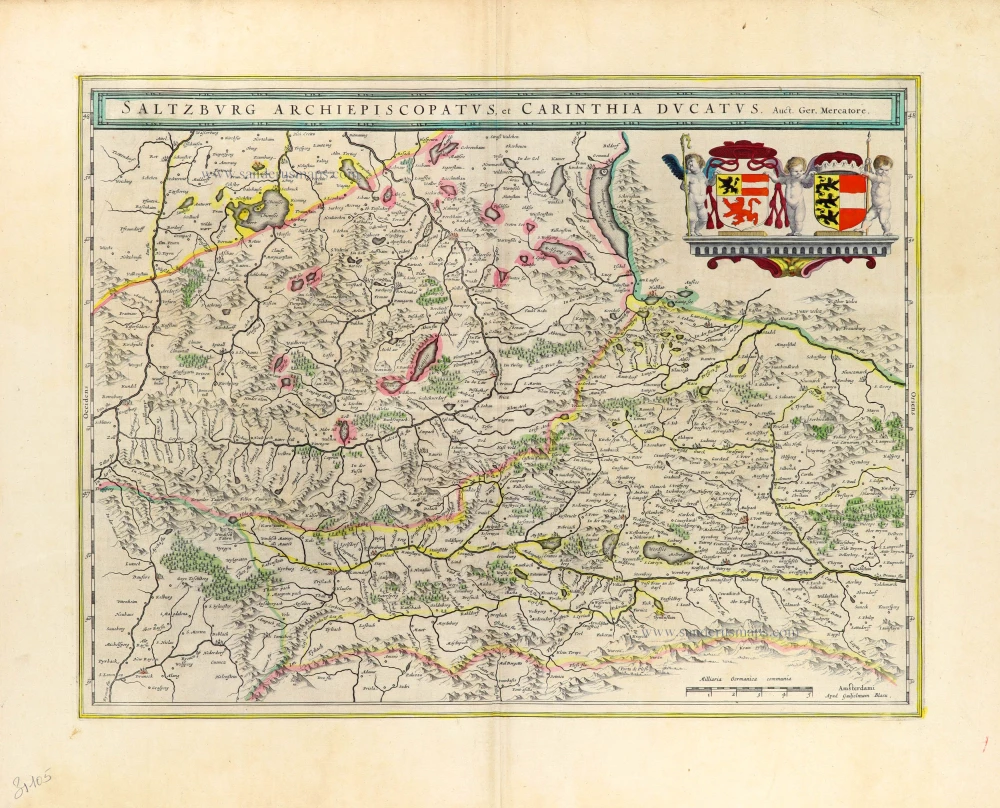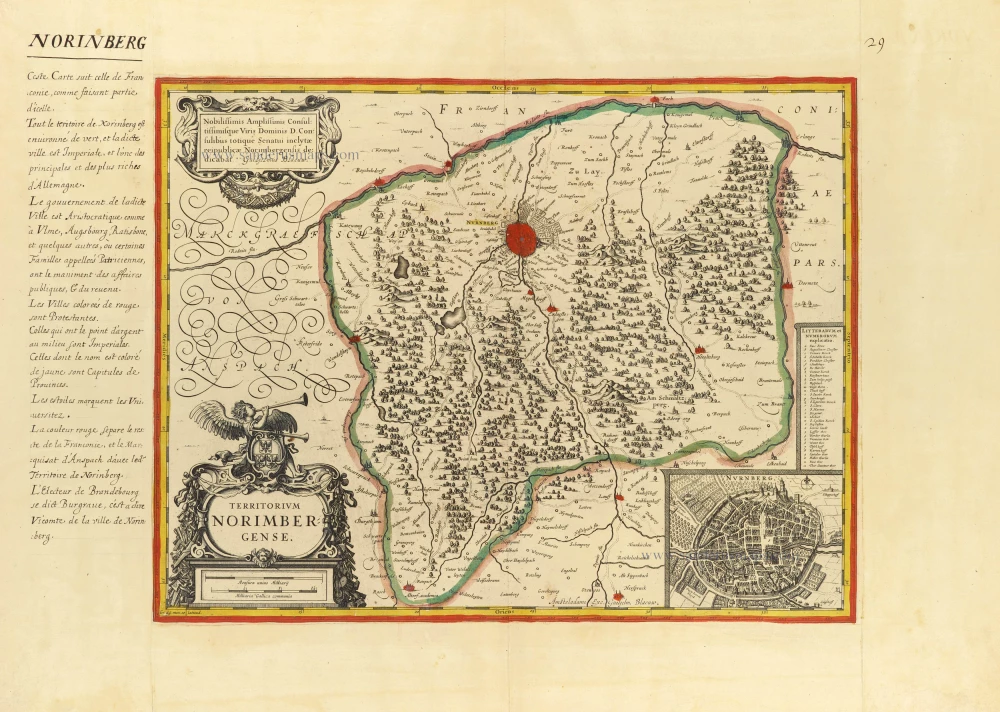Nürnberg - Ulm - Salzburg - Lindau by Braun & Hogenberg 1572-1624
NUREMBERG (NÜRNBERG)
TRANSLATION OF CARTOUCHE TEXT: Nuremberg is a flourishing German trade city, widely famed for its excellent civic constitution; within the order of rank of burgraves in the Holy Empire, it occupies second place.
COMMENTARY BY BRAUN: "Nuremberg is highly famed in all Germany and Europe as an important trade city and is embellished with splendid public and private houses. Nuremberg possesses an ancient royal fortress on a hill in the middle of the city, offering a view of the city and far beyond. Nuremberg is thought to have taken its name from this fortress, which in old books is called Nordgauburg or Nordburg [...]. Many astute craftsmen and prudent merchants, very many fine and creative inventors and masters live there."
Source: Hartmann Schedel, Nuremberg Chronicle, 1493. The showy double-sided view has shaped the way the city of Nuremberg is perceived in Hartmann Schedel's 1493 Chronicle. Schedel presented an ideal picture of a city well fortified with a double ring wall, full of beautifully ordered patrician houses and boasting St Sebald's church and St Lawrence's church. The high point of all this glorious urbanity in Schedel is the imperial castle looming high above the city. In his text, Braun emphasises the castle, which afforded superb views. However, the two pictures in Braun-Hogenberg are not dominated by the steeply rising fortress; indeed, the differences in elevation within the city have been considerably levelled off.
ULM
CARTOUCHE: Ulm, an imperial city in Swabia, famed for its solid walls and moats, its magnificent church and the nearby Danube.
COMMENTARY BY BRAUN: "Ulm is a splendid city in Swabia on the north bank of the Danube at its junction with the Iller and the Blau, whose additional waters make the Danube navigable. In this city, a parish church was built for the lofty sum of 900,000 gold guilders. The inhabitants live partly from commerce and partly from crafts. A special cloth made of linen, cotton and yarn is manufactured here, which they call fustian."
The view from Michelsberg hill shows Ulm well protected by high walls and its riverside location. The major landmarks are clearly captioned: Ulm's famous cathedral (Munster), the largest parish church in Germany, and the Gothic town hall (Rathaus), slightly in front of it to the left. The smaller monasteries and the formidable city gates can also be easily identified. Ulm reached its chief industries, conducting a flourishing trade in iron, wine and wood. The city was also famous for its artists, artisans, and book printing.
The view is made after an etching by Georg Rieder the Younger, 1570.
SALZBURG
CARTOUCHE: Faithful illustration of the city of Salzburg.
COMMENTARY BY BRAUN: "Lakes, plains, hills and mountains surround Salzburg. The lakes provide fertile meadows, the mountains fowling and hunting [...]. Franciscus Irenicus ranks Salzburg in the first place amongst the five bishoprics of Bavaria and expressly praises this episcopal city, which Enea Silvio Piccolomini even calls a capital."
This is a highly schematic view of Salzburg from on top of Kapuzinerberg. The 11th-century fortress of Hohensalzburg, the largest castle complex in Europe, is easily recognisable in its dominant position above the city. In contrast, the buildings below are condensed into narrow blocks in favour of wide streets and squares. However, the impression of spaciousness does not correspond to the actual appearance of the city wedged between the Mönchsberg and the Kapuzinerberg. Braun refers to the legendary history of Salzburg, which claims Julius Caesar founded it. Salzburg is first mentioned in records in AD 755 as a trading settlement. In 996, it was granted the right to hold a market and mint its coins, and in 1287, it received its municipal charter. From the 16th century onwards, Salzburg played an essential role as a city of trade and as the residence of the prince-archbishops. Following a devastating fire in 1598, Archbishop Wolf Dietrich of Raitenau had 55 townhouses demolished to make space for a new cathedral and a grander street plan. The new cathedral in the Baroque style continues to leave its stamp on the face of Salzburg even today.
The view is made after a drawing by an unknown artist, 1553, which was used both for the woodcut in Münster's Cosmographia and the map of Austria in Ortelius's Theatrum Orbis Terrarum.
LINDAU
CAPTION: Lindau, an imperial city on an island, surrounded by the waters of Lake Constance.
COMMENTARY BY BRAUN: "Lindau is an imperial city that lies below Bregenz on Lake Constance, and which is surrounded by water like an island and is connected to the mainland only by a masonry bridge of 290 paces. [...] To the west lies a large and wide field that in normal years can produce some 100 tons of wine."
Several of Lindau's historical sights are recognisable in the engraving. On the left is St Stephen's church, begun in the 12th century and frequently altered, and on the right, as part of the city defences, the "Thieves' tower" (Diebsturm) of 1380 with its four overhanging turrets. Directly to its left is St Peter's, Lindau's oldest church, which dates from the 12th century and contains valuable frescoes by Hans Holbein, the Elder. Lindau goes back to a nunnery first mentioned in records in AD 822. The town was granted its charter before 1216 and, from c. 1300 to 1803, was an imperial city.
The view is made after a woodcut by Jakob Clauser in Münster's Cosmographia, 1550.
Nurnberga Florentissimum Germaniae Emporium, ... [on sheet with] Ulma Imperialis in Suevia [and] Saltzburg Urbis Salisburgensis Genvina Descriptio [and] Lindaw - Lindoia, Oppidum Imperij insulare, ...
Item Number: 23336 new Authenticity Guarantee
Category: Antique maps > Europe > Austria
Nürnberg - Ulm - Salzburg - Lindau by Braun & Hogenberg.
Title: Nurnberga Florentissimum Germaniae Emporium, ... [on sheet with] Ulma Imperialis in Suevia [and] Saltzburg Urbis Salisburgensis Genvina Descriptio [and] Lindaw - Lindoia, Oppidum Imperij insulare, ...
Date: 1572-1624.
Copper engraving, printed on paper.
Size (not including margins): 335 x 470mm (13¼ x 18½ inches).
Verso: Latin text.
Condition: Superb old colour, excellent.
Condition Rating: A+.
From: Civitates Orbis Terrarum, ... Part 1. Köln, 1572-1624. (Van der Krogt 4, 41:1.1)
NUREMBERG (NÜRNBERG)
TRANSLATION OF CARTOUCHE TEXT: Nuremberg is a flourishing German trade city, widely famed for its excellent civic constitution; within the order of rank of burgraves in the Holy Empire, it occupies second place.
COMMENTARY BY BRAUN: "Nuremberg is highly famed in all Germany and Europe as an important trade city and is embellished with splendid public and private houses. Nuremberg possesses an ancient royal fortress on a hill in the middle of the city, offering a view of the city and far beyond. Nuremberg is thought to have taken its name from this fortress, which in old books is called Nordgauburg or Nordburg [...]. Many astute craftsmen and prudent merchants, very many fine and creative inventors and masters live there."
Source: Hartmann Schedel, Nuremberg Chronicle, 1493. The showy double-sided view has shaped the way the city of Nuremberg is perceived in Hartmann Schedel's 1493 Chronicle. Schedel presented an ideal picture of a city well fortified with a double ring wall, full of beautifully ordered patrician houses and boasting St Sebald's church and St Lawrence's church. The high point of all this glorious urbanity in Schedel is the imperial castle looming high above the city. In his text, Braun emphasises the castle, which afforded superb views. However, the two pictures in Braun-Hogenberg are not dominated by the steeply rising fortress; indeed, the differences in elevation within the city have been considerably levelled off.
ULM
CARTOUCHE: Ulm, an imperial city in Swabia, famed for its solid walls and moats, its magnificent church and the nearby Danube.
COMMENTARY BY BRAUN: "Ulm is a splendid city in Swabia on the north bank of the Danube at its junction with the Iller and the Blau, whose additional waters make the Danube navigable. In this city, a parish church was built for the lofty sum of 900,000 gold guilders. The inhabitants live partly from commerce and partly from crafts. A special cloth made of linen, cotton and yarn is manufactured here, which they call fustian."
The view from Michelsberg hill shows Ulm well protected by high walls and its riverside location. The major landmarks are clearly captioned: Ulm's famous cathedral (Munster), the largest parish church in Germany, and the Gothic town hall (Rathaus), slightly in front of it to the left. The smaller monasteries and the formidable city gates can also be easily identified. Ulm reached its chief industries, conducting a flourishing trade in iron, wine and wood. The city was also famous for its artists, artisans, and book printing.
The view is made after an etching by Georg Rieder the Younger, 1570.
SALZBURG
CARTOUCHE: Faithful illustration of the city of Salzburg.
COMMENTARY BY BRAUN: "Lakes, plains, hills and mountains surround Salzburg. The lakes provide fertile meadows, the mountains fowling and hunting [...]. Franciscus Irenicus ranks Salzburg in the first place amongst the five bishoprics of Bavaria and expressly praises this episcopal city, which Enea Silvio Piccolomini even calls a capital."
This is a highly schematic view of Salzburg from on top of Kapuzinerberg. The 11th-century fortress of Hohensalzburg, the largest castle complex in Europe, is easily recognisable in its dominant position above the city. In contrast, the buildings below are condensed into narrow blocks in favour of wide streets and squares. However, the impression of spaciousness does not correspond to the actual appearance of the city wedged between the Mönchsberg and the Kapuzinerberg. Braun refers to the legendary history of Salzburg, which claims Julius Caesar founded it. Salzburg is first mentioned in records in AD 755 as a trading settlement. In 996, it was granted the right to hold a market and mint its coins, and in 1287, it received its municipal charter. From the 16th century onwards, Salzburg played an essential role as a city of trade and as the residence of the prince-archbishops. Following a devastating fire in 1598, Archbishop Wolf Dietrich of Raitenau had 55 townhouses demolished to make space for a new cathedral and a grander street plan. The new cathedral in the Baroque style continues to leave its stamp on the face of Salzburg even today.
The view is made after a drawing by an unknown artist, 1553, which was used both for the woodcut in Münster's Cosmographia and the map of Austria in Ortelius's Theatrum Orbis Terrarum.
LINDAU
CAPTION: Lindau, an imperial city on an island, surrounded by the waters of Lake Constance.
COMMENTARY BY BRAUN: "Lindau is an imperial city that lies below Bregenz on Lake Constance, and which is surrounded by water like an island and is connected to the mainland only by a masonry bridge of 290 paces. [...] To the west lies a large and wide field that in normal years can produce some 100 tons of wine."
Several of Lindau's historical sights are recognisable in the engraving. On the left is St Stephen's church, begun in the 12th century and frequently altered, and on the right, as part of the city defences, the "Thieves' tower" (Diebsturm) of 1380 with its four overhanging turrets. Directly to its left is St Peter's, Lindau's oldest church, which dates from the 12th century and contains valuable frescoes by Hans Holbein, the Elder. Lindau goes back to a nunnery first mentioned in records in AD 822. The town was granted its charter before 1216 and, from c. 1300 to 1803, was an imperial city.
The view is made after a woodcut by Jakob Clauser in Münster's Cosmographia, 1550.

